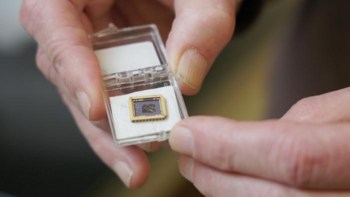
The pitter-patter of raindrops on a plastic panel could be a new source of electricity thanks to work done by researchers at France’s Atomic Energy Commission (CEA) in Grenoble.
While humans have harnessed the power of rain for thousands of years, energy is usually extracted from rainwater as it flows downhill in a river or stream. Now, Jean-Jacques Chaillout and colleagues have created a panel that converts the impact energy of falling raindrops directly into electricity.
Their device uses a plastic called polyvinylidene fluoride (PVDF) that vibrates when struck by raindrops. PVDF is a piezoelectric, which means that some vibrational energy is converted into electricity. Such devices could power remote sensors and other electronic devices, claim the researchers.
Impact energies
The team studied several different types of rainfall and found that drizzle produced millimeter-wide droplets with an impact energy of around 2 µJ, while a downpour involved drops that were about 5 mm across and produced an impact energy five hundred times greater.
Chaillout and colleagues then used computer simulations to estimate how much of this energy could be recovered as electricity when raindrops fall onto PVDF, which was chosen because it is easy to shape into sturdy panels and does not contain toxic materials (Smart Mater. Struct. 17 015038).
Although the physics of how a raindrop interacts with a surface is not fully understood, the simulations allowed the team to estimate which configurations of PVDF were best at harvesting energy from a wide range of raindrop sizes.
The team settled on a device based on a 10 cm strip of PVDF just 25 µm thick, which they then built and tested (Smart Mater. Struct. 17 015039). Electrodes were embedded in the strip to recover the electrical energy generated and the device was placed below a pipette that could be adjusted to create water droplets of different sizes and at realistic rainfall speeds.
Chaillout and colleagues discovered that slow falling raindrops generated the most electrical energy, because faster raindrops often lose some energy by splashing. Depending on the raindrop size, the harvesting system could generate between 1 µW of continuous power for the smallest up to 12 mW for larger downpour drops.
Although the output is tiny compared to other harvesting systems such as solar panels, which can deliver hundreds of watts, rain power could provide a good alternative in rainy outdoor environments where solar energy is difficult to exploit — and, of course, it works in the dark.
One intriguing use is to power remote sensors inside the cooling towers of conventional power stations. These would harvest their energy from falling droplets formed by condensing steam as it rises, and could track limescale build-up within the tower, improving the power station’s efficiency.
The team plans to create such a limescale sensor and are also working on ways of storing the electrical power generated, so that it can provide a steady current for practical use.



